The Global Economy.
Thesis
Vanguard Total World Stock Index Fund ETF Shares (NYSEARCA:VT) is touted as the perfect “set it and forget it” investment. There is even an entire subreddit “Bogleheads” dedicated to this passive investment strategy philosophy: “VT and Chill”. While the fund and underlying index have a positive return and efficient investment vehicle, I believe its allocation to international stocks is too heavy causing significant long-term underperformance compared to investing in the US Stock Market alone.
Portfolio Strategy and Performance
VT is offered by Vanguard Group, one of the largest and most well-known investment management companies. The VT ETF aims to provide investors with broad exposure to the global stock market by tracking an index that includes both U.S. and international stocks. It is designed to give investors a diversified portfolio that represents the entire global equity market, making it a popular choice for those looking for global equity exposure within a single investment. The strategy of the fund provided by fund management is as follows:
Vanguard Total World Stock ETF seeks to track the investment performance of the FTSE Global All Cap Index, a free-float-adjusted, market-capitalization-weighted index designed to measure the market performance of large-, mid-, and small-capitalization stocks of companies located around the world. The index includes stocks of companies located in various countries, including both developed and emerging markets. The fund invests in a broadly diversified sampling of stocks in the index that approximates the index’s key risk factors and characteristics.
With $27B AUM, a low expense ratio of 0.07%, and almost 10,000 holdings, VT is the ultimate buy the haystack ETF.
VT Holdings (Seeking Alpha) VT Total Returns Since Inception (Seeking Alpha)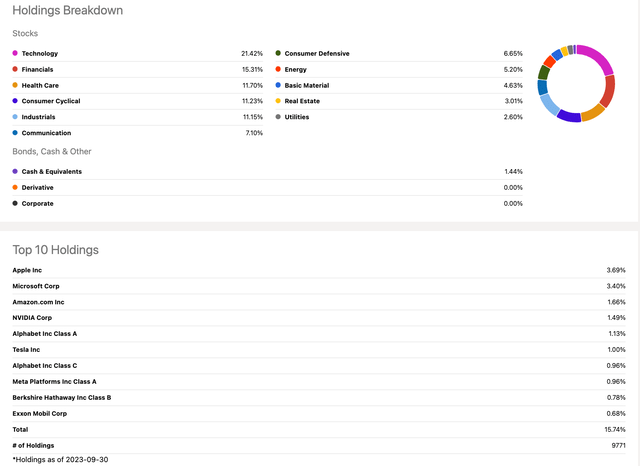

Since its inception in June 2008, VT has a total return of 154.50%. In the last ten years, VT has a total return of 53.40% vs. 121.58% compared to Vanguard Total Stock Market Index Fund ETF Shares (VTI). This massive underperformance is attributed to VT being split 60% US Total Stock Market and 40% international or Ex-US Stock Market.
VT vs. VTI Total Returns 2013-2023 (Seeking Alpha)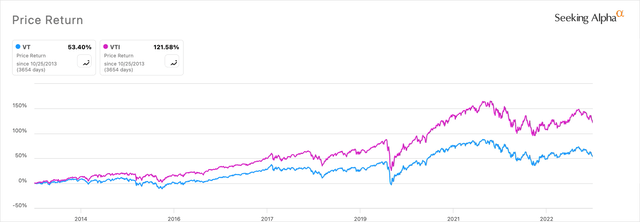
Why I Can’t VT And Chill
- Foreign Tax Credit
- Historical 37 year Backtest
- Retirement Consideration
First off, VT, with its 60/40 US/Ex-US balance, is not eligible for the foreign tax credit. The foreign tax credit is a US tax credit to offset income tax paid abroad. The credit can reduce your US tax liability to ensure you aren’t taxed twice on the same income. Who wants to pay taxes twice? VT will have you do it according to 26 U.S. Code § 853 – Foreign tax credit allowed to shareholders
(1) more than 50 percent of the value (as defined in section 851(c)(4)) of whose total assets at the close of the taxable year consists of stock or securities in foreign corporations, and (2) which meets the requirements of section 852(a) for the taxable year, may, for such taxable year, elect the application of this section with respect to income, war profits, and excess profits taxes described in section 901(b)(1), which are paid by the investment company during such taxable year to foreign countries and possessions of the United States.
To give VT a fair shake, I ran the numbers referencing Vanguard Total International Stock Index Fund ETF Shares (VXUS) from the 2022 Foreign tax credit information which is 8.52% of the dividend income paid. In 2022, VXUS paid a total of $1.599/share in dividends, so that’s $0.1362/share in tax. Now, because VT is only 40% Ex-US, I can only take $0.0544/share as tax credit. If I have $1M today in VT at $89/share that’s 11,236 shares, so that’s a total of $611/$1M invested. If you’re living off of say 4% of that $1M, it’s essentially a 1.5% fee on your $40,000/year income. The taxes are similar to the difference of an expense ratio when comparing other funds, in this year, about 0.06% additional expense ratio. For someone retired, $600+ per year is fairly significant, that’s covering internet or water bill or energy bill for the year.
Second, a VT surrogate backtest using a $10,000 initial investment. highlights a consistent underperformance of international stocks which contributes to a significant difference in long-term returns from 1986-2023, 37 years, the longest data I can find for a backtest:
VT Surrogate vs. US Stock Market vs. Ex-US Stock Market (Portfolio Visualizer) VT Surrogate vs. US Stock Market vs. Ex-US Stock Market (Portfolio Visualizer)
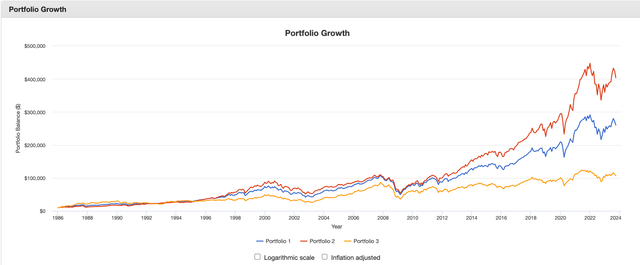
Portfolio 1 = VT Surrogate 60/40 US/Ex-US Stock Market
Portfolio 2 = 100% Total US Stock Market
Portfolio 3 = 100% Ex-US Stock Market
The CAGR difference between Portfolio 1 and 2 is only 1.27% CAGR but over 10, 20, 30 years that will really add up. The difference in total returns is about $260k vs. $401k or 54% more in value over 37 years. Most of the reason Portfolio 1 is even competing with Portfolio 2 is not because of the international stocks but because of the US Stocks themselves. You would have been better off since the mid-1990s with just US Stocks alone. That’s a long time and not unreasonable for someone who retired at 55 with $500k, the equivalent of $1M today, in 1995. Let’s see:
4% SWR 1995-2023 Performance Summary: VT Surrogate vs. US Stock Market vs. Ex-US Stock Market (Portfolio Visualizer) 4% SWR 1995-2023 Annual Income: VT Surrogate vs. US Stock Market vs. Ex-US Stock Market (Portfolio Visualizer)
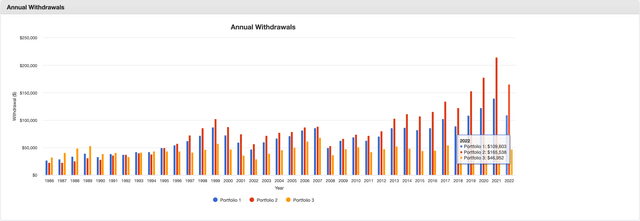
Using the same portfolios and 4% SWR, while both Portfolio 1 and 2 US had positive inflation-beating performance from 1995-2023, a US-only allocation would have earned you $1.5M more during retirement. Not to mention in 2022, $165.5k vs. $109.5k in annual income. Last, not that one would have 100% international stocks during retirement but just know, their contribution in a 60/40 split returned -0.46% CAGR adjusted for inflation, a clear dog in your portfolio all for perceived “diversification”.
Risk Analysis
- Past vs. Future Performance
- Rebalancing Error
- Locations of the Business Operations
Of course, the first disclaimer I must give is past performance does not indicate future results. My backtest does not include 1975-1983 where international stocks outperformed US, though less relative performance difference compared to US outperformance cycles. This would lessen the total return discrepancy priced in from 1986. A pattern commonly cited is US and International performance differences are cyclical and they take turns outperforming each other for periods of time. We’re coming off 12 years of US outperformance and many speculate it’s time for the cycle to flip again, for no purpose other than the pattern observed.
US Equity vs. International Equity 5-Year Monthly Rolling Returns 1975-2023 (Hartford Funds)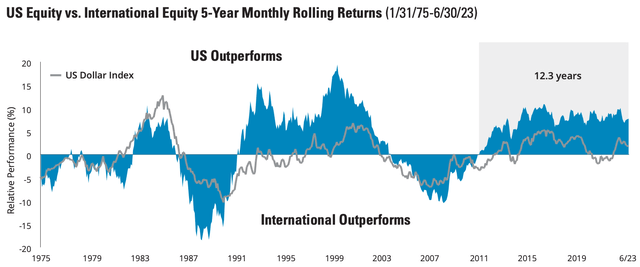
Another risk is if you are seeking international exposure but want to control the allocation by using something like VTI+VXUS, you could rebalance sub-optimally and take on unwanted tax liabilities by doing so. This could outweigh the cons of no foreign tax credit and being married to strict market capitalization allocation rules. In the long run, you could be better off just letting the fund automatically rebalance for you instead of manually making this decision and risking doing it incorrectly.
Last, we must be wary of where large market cap companies are located. The top 10 stocks, about 16% of VT, are all US-based companies. These are market movers. Should several large cap companies not be based in the US become top companies, this can have a significant effect on the speculation of international stock exposure in one’s portfolio. For example, imagine if the next wave of AI companies develop large market caps rivaling Apple and Microsoft but are not based in the US. If you have 100% US Stocks only, you would miss the run-up of a fantastic set of stocks not based in the US.
Forward-Looking Sentiment
All in all, while I like the idea of a “set it and forget it” ETF, I don’t believe VT is it. Its significant historical underperformance to the US Total Stock Market makes me undoubtedly not buy this fund or consider it in my retirement portfolio. The double taxation on foreign income also wouldn’t have me consider this fund when I can just buy 60% VTI and 40% VXUS and keep the extra with a slightly lower expense ratio.
It’s worth noting that the location of large market cap companies does not necessarily indicate their international exposure, numerous US-based companies have substantial global operations and sales which ultimately generate earnings and market caps. I think that’s the misunderstanding with VT, it’s not explicitly trying to be a perfect US and International balanced fund, rather it’s simply normalized and indexed by the market cap of pretty much every company on Earth, which the US just happens to represent 60% of. And with that, you get whatever US/international domains these companies are exposed to. Overall, I personally prefer S&P 500 funds for their time-tested returns for “set it and forget it” accumulation. That’s what all my retirement accounts are set to, for now. S&P 500 and Chill.
Read the full article here



